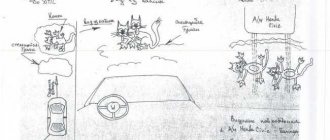An accident (traffic accident) is an unpleasant event. But the injured party can be pleased with one circumstance: the damage will most likely be compensated by the insurance company (IC). And the culprit, in most cases, will not suffer financially if everything is in order with his MTPL policy and there are no other reasons for non-payment of compensation.
However, so that financial claims from the insurer do not come as a surprise, it is better to familiarize yourself with the concepts of “regression” and “subrogation”. Using these mechanisms, insurance companies can shift the damage they suffer to the other party.
Concepts
The easiest way to explain the meaning of the concepts “regression” and “subrogation” is with specific examples.
Subrogation
A car insured under an MTPL policy hits a pothole and is damaged. The insurer compensates him for the damage. But the road balance holder is to blame for the occurrence of an emergency. This is usually the local administration (roads within settlements) or the regional government (roads between settlements).
The company compensates the victim for damages, but may, in turn, make claims against the guilty party. This is subrogation.
Most often, this mechanism is used for payments under CASCO: the insurer reimburses compensation, then recovers its costs from the culprit or his insurance company.
Regression
If several cars were involved in an accident, and the culprit has a compulsory motor liability insurance policy, his insurance company will compensate the victims for damage within the limits established by law.
But in certain cases (the driver was not included in the insurance, was intoxicated, fled the scene of the accident), the insurer may recover the costs incurred from the culprit. This is a recourse claim against the culprit of the accident (regression).
Features of subrogation
The development of the institution of subrogation solves several problems. Firstly, it limits the possibility of using various fraudulent schemes. Secondly, thanks to this system there is a legal way to recover damages from the real culprit of the incident. This is, in a sense, progress in insurance legislation.
The right of an insurance company to subrogation is prescribed in the Civil Code of the Russian Federation. And here it is indicated that the parties (insurer, policyholder) may refuse to use this process if the damage was caused unintentionally.
In other situations, not only insurance companies can request compensation (in the amount of costs incurred), but also victims if the insurance payment does not cover the amount of damage.
The insured may also waive claims against the person who caused the damage. In this case, the insurance company is exempt from paying compensation (in whole or in part).
In addition, which is logical, the volume of the insurer's claims within the framework of subrogation cannot exceed the amount of compensation paid to it.
Features of regression
The right of the insurance company to a recourse claim, according to which damage can be recovered from the policyholder, is prescribed in the law on compulsory motor liability insurance. If an insurance company client is found guilty of an accident, the organization will pay for the damage caused. But in some cases it has the right to recover compensation from him.
This may be in the following situations:
- Intentional damage.
- Driving while under the influence of alcohol (drugs, toxic substances).
- The culprit does not have documents allowing him to drive a vehicle.
- Escaping from the scene of an accident.
- The culprit is not included in the insurance.
- The MTPL policy is expired.
In what cases can it be
The insurer has the right to launch a recourse mechanism against the culprit on the basis of the replacement of the debtor. But the insurer can apply this right only in certain cases, otherwise for the culprit after an accident through his fault, having an MTPL insurance policy would be meaningless.
After all, he would not have been able to use the insurance amounts to cover the debt to the victim if the policy provided for full recourse in any case of an accident, for any culprit and for any reason.
However, the insurance company has the right to demand the return of amounts from the person responsible for the road accident, who is also its client, only in certain cases:
- when the culprit was in a state of alcohol, drugs or any other intoxication at the time of the road accident, which led to a violation of his concentration on the road while driving;
- when the culprit of the accident was driving without a driver’s license while driving on the road or his license expired, because 10 years after receiving a driver’s license, they need to be renewed, otherwise it will be considered that you simply do not have one;
- when the culprit had no other rights to drive a car, for example, there was no power of attorney issued in his name;
- when a truck driver has an expired inspection ticket;
- when the culprit of an accident is not included in the compulsory motor liability insurance policy that he has in hand - this often happens due to the negligence of the transport company-insurer, whose employees forget to include their drivers in the policy;
- when the person responsible for the accident flees the scene of the accident on the road;
- when the accident happened at a different time when the culprit was using the car, and not during the period specified in the policy;
- when the culprit deliberately provoked the accident or was directly involved in it according to his plan, which led to damage to the victims.
Thus, we reach the conclusion that only in the presence of illegal actions on the part of the culprit, and not in the case of accidental and unintentional causes of a road accident, can recourse be realized on the part of the culprit’s insurance company. Therefore, you should be careful, careful and not break the law.
Comparison
Many people do not know that subrogation and subrogation in insurance have a fundamental difference.
Differences
Subrogation only implies a change in the party obligated to compensate for the damage caused. And recourse is a new requirement in accordance with which the insurer recovers its costs from the client.
There are also differences in the rules for calculating the limitation period.
Common features
The institutions of subrogation and recourse have an educational meaning. Thanks to these phenomena, the responsibility to compensate for the damage falls on those responsible for causing it.
Example
Let's say the owner of a car with a CASCO policy damaged the bumper by running over a curb. The insurance company will fully reimburse the costs of such an insured event (repairs). Since in this situation there is no second guilty party, there is no one to send a counterclaim to - it is impossible to apply regression and subrogation.
However, if the driver was intoxicated at the time of the accident, then the insurance company has the right to make a recourse claim against him.
If the collision with the curb occurred due to the fault of another person (for example, a driver who drove into oncoming traffic), then subrogation may be applied to him.
Regression under OSAGO
Recourse is the determination of the right of the insurance company to demand from the insured person (the culprit of the accident) compensation for losses incurred as a result of payment of compensation for the damage caused to him.
When can it be presented?
All cases that give the insurer the right to resort to regression are prescribed in the law on compulsory motor third-party liability insurance. Generally speaking, the insurance company client must not only be at fault for the accident, but also a violator under the insurance contract.
Is it possible to avoid
In order not to be subject to recourse, the person at fault for the accident should not violate the terms of the insurance contract and the norms prescribed in the law on compulsory motor liability insurance.
That is, take care of the relevance of the MTPL policy, do not drive while intoxicated, and in the event of an accident, do not panic and do not try to escape.
In what cases can they collect
Not only the insurance company can recover damages from the client (in case of violations that give it the right to a regressive claim), but also the victims. This is permissible if the insurance amount does not fully cover the damage caused by it. These issues are usually resolved in court if the culprit refused to pay compensation voluntarily.
Regression in insurance under compulsory motor liability insurance - when can it be presented?
As a rule, when indemnifying under compulsory motor liability insurance we are talking about subrogation, however, there are situations when recourse occurs. However, these situations are strictly limited by the legislator. All these cases are united by the fact that the person at fault for the accident must also be a violator under the insurance contract.
That is, being in a state of alcohol or drugs at the time of the accident, fleeing the scene of the accident, intentionally causing harm to the victim, and others.
This is a significant difference between recourse and subrogation; the insurance company can demand compensation from a person who is its client. In subrogation, the victim contacts his insurance company, it pays him compensation, and then turns to the person at fault; no insurance contract has been concluded between them.
Grounds for filing a recourse claim
All the grounds that give the insurance company the right to recourse are spelled out in Article 14 of the law on compulsory motor liability insurance.
The Investigative Committee may put forward a regressive claim against the culprit of the accident if the following facts are revealed:
- Intent. If damage to property, life or health was caused intentionally, then compensation for damage may be assigned to the person responsible for the accident.
- Drunk. Any intoxication (alcohol, drugs, toxic) gives the insurance company the right to impose financial liability on the culprit client.
- Management without rights. Regression can be caused by the insured not having documents allowing him to drive a car. You need to understand: if you simply don’t have a driver’s license with you (but you do have one), then this does not mean that you have no right to drive in general.
- Escaping from the scene of an accident. This is punishable by one to 1.5 years of deprivation of a driver's license or up to 15 days of arrest. In addition, in case of hiding, the culprit of the accident will have to independently compensate for the damage to the victims.
- Not covered by insurance. If the insurance policy is limited in the number of insured, and the culprit of the accident is not included in it, then he himself bears financial responsibility in the event of an accident.
- Expired insurance. Each policy specifies the period during which it is valid.
- Didn't notify the insurance company. If an accident is reported without calling the police, then the person responsible for the accident must notify his insurance company about the incident within five days. The client must provide the insurer, in addition to the notice, with a completed European protocol form. Otherwise, there is a risk of regression.
- Technical inspection. Many people think about getting a diagnostic certificate (technical inspection) just to apply for insurance. However, if the person at fault for the accident has an overdue inspection, then the cost of repairing the victim’s car will fall on his shoulders.
- False data in the electronic policy. If, in order to obtain an electronic compulsory motor liability insurance policy, the client provided the insurer with inaccurate data, as a result of which the amount of the insurance premium decreased, this is the basis for the use of a recourse mechanism.
- Other reasons. If an accident was reported without calling the police, then the culprit cannot begin repairing (disposing of) the vehicle involved in the accident until 15 calendar days have passed from the date of the incident. Non-working holidays are not taken into account. In addition, at the request of the insurance company, this vehicle must be provided for inspection and/or technical examination.
What reasons could there be?
The second common mistake regarding the concept of recourse is the substitution of the concepts - recourse and subrogation.
People constantly confuse these words, or even imply that they are synonyms, meaning the same action on the part of the insurance company.
Employees of insurance companies also made a lot of mistakes using these terms because they did not fully understand how to act in relation to their clients in the event of an accident. Therefore, one should also define the term – subrogation.
Subrogation is the transfer of the right to claim the amount that was paid by the insurer (beneficiary) to the victim, the payment of the culprit to his insurer (Clause 1 of Article 965 of the Civil Code of the Russian Federation).
Agree, it sounds the same and you may get the impression that they are one and the same. It seems that the culprit of the accident is the person “responsible for losses”, but this is not so. Rather, he is the causer of the damage, and the person responsible for this damage is the insurance company.
Therefore, the insurance company cannot recover from itself the amounts paid to the victim under the obligation of the compulsory motor liability insurance agreement with the culprit.
In an example it might look like this. Subrogation - Kolya owes Petya a sum of money, then Vasya comes and offers to pay this debt to Kolya for Petya. Kolya doesn’t care who returns the money to him, so he agrees. He no longer receives his money from Petya, the original debtor, but from Vasya. Then Vasya now has the right to demand the debt from Petya, and not Kolya.
But with recourse, the transfer of rights does not occur at all; here the picture is different, from the point of view of insurance law.
Regression - Kolya agrees to replace Vasya’s accidentally broken glass without consequences for the culprit. But suddenly, Kolya, after he had already inserted the glass, finds out that Vasya broke the glass on purpose.
Then Kolya has the right to demand from Vasya compensation for the cost of not only the glass, but also the work of inserting it into the frame. It looks more like a punishment.
Therefore, the basis for applying the recourse mechanism is the intentional unlawful actions of the culprit of the accident.
This may be a recourse under compulsory motor liability insurance when fleeing the scene of an accident or the insurer’s requirement to pay the amount repaid to the victim to the insurance company’s cash desk due to the alcohol intoxication of the culprit driver. There are also a number of other cases in which the culprit of an accident is a violator of the law.
Understating the amount of payment under compulsory motor liability insurance is discussed in the article: problems of compulsory motor liability insurance. Read how to buy an MTPL policy from Sogaz here.
How much can they charge?
As already mentioned, the amount of recourse claims cannot exceed the amount of compensation paid by the insurer to the victims.
In addition, the total amount of claims may include:
- the amount of compensation paid by the insurance company to the injured party;
- legal costs of the insurer;
- expenses of the Investigative Committee for carrying out the necessary examinations;
- expenses of the company for conducting insurance business (the amount is determined by the insurer).
The law defines the upper limits of payments under compulsory motor liability insurance for victims of road accidents. Compensation for property damage cannot exceed 400 thousand rubles, damage to health - 500 thousand rubles. That is, for each case, depending on the situation, a separate calculation will be carried out.
For example, after a road accident a European protocol was drawn up. The person at fault did not notify his insurance company about the accident. As a result of the accident, property damage in the amount of 170 thousand rubles was caused. The culprit's insurance company compensates the injured party for these losses and makes recourse claims to the client. The policyholder does not agree with them. The insurance company files a lawsuit, demanding that the client reimburse 170 thousand rubles. and the amount of legal costs, which, for example, amounted to 12 thousand rubles. Thus, the total amount of claims will be 182 thousand rubles.
What is the amount of recourse under compulsory motor liability insurance?
Part 1 of Article 14 of Federal Law No. 40 indicates the possibility of demanding regressive payments in the amount of compensation previously paid to the victim . However, that's not all, because... Part 3 of the same article also indicates the possibility of demanding payments equal to the costs incurred by the insurer to consider the insured event.
The latter means that the insurer can include in the total recovery all costs that are in one way or another related to the case in question : compensation, examinations, legal costs, etc.
How to deal with the culprits
In the event of an accident, the insurer examines the circumstances of the accident and finds out whether its client’s illegal actions were among its causes. If any, the company must prepare documents that will justify the amount of damage it has suffered and submit a claim to the insured person.
In such a situation, it is better not to try to evade responsibility. You must carefully read all documents. If the demands are fair, and the damages assessed correspond to those indicated in the protocol, then it is better to try to resolve the issue peacefully.
If the insurance company overestimates the amount of the claim, you must request copies of all documents and contact an independent appraiser. All disagreements are settled, as a rule, in court.
Useless disputes
Often clients refuse to pay under regression, citing the fact that they do not admit their guilt. This will not help you avoid payments. If the court establishes the fact of guilt during the proceedings regarding the accident, then it is not necessary to do this separately when submitting recourse claims.
If you have nothing to pay
There is a way out of any situation. One of them is an agreement with the insurance company, according to which compensation for a recourse claim can be paid in installments.
Another method is litigation. The insurer goes to court, and the court makes a decision to recover damages. After it comes into force, a writ of execution is issued, according to which the debt is automatically reimbursed from part of the debtor’s official income.
How to appeal against the insurance company's recourse to the person at fault for an accident
Regression following an accident goes through several mandatory stages. The pre-trial procedure consists of sending a written claim. If you do not pay, a claim will be filed in court. Here are some recommendations that will allow you to defend your interests and challenge the court’s decision:
- pay close attention to the paperwork at the scene of the incident, ask for your objections and additions;
- take part in the inspection of the damaged vehicle;
- Receive documents by mail and subpoenas in a timely manner;
- when submitting recourse claims, immediately contact a lawyer;
- Be sure to participate in court hearings and file complaints against the decision in a timely manner.
Find out more fatal accidents
Even if the court upheld the claim, this is not a reason to give up and immediately pay the insurer. An appeal may be filed within 30 days, and the decision that has entered into force can be canceled through cassation and supervision. If these measures do not bring results, you can achieve a deferment or installment plan for payments. Such methods of protection must also be taken through the courts.
How to reduce recourse requirements
If the insurance company paid money to the victim and requires recourse compensation from you, you can try to reduce the amount of compensation. This is easier to do if immediately after the accident you took part in paperwork and inspecting the damaged car. You can use the following options to reduce the amount of the penalty:
- receive a vehicle inspection report, order an independent examination;
- check the list of damages and work performed at the service station, request the exclusion of unnecessary spare parts;
- make sure that the amount of insurance paid corresponds to the requirements.
The Civil Code of the Russian Federation obliges the plaintiff to prove the amount of the claims. Therefore, in the legal process, the insurance case materials will necessarily be checked in order to avoid overestimating the amount of the claim. The insurer has no right to refuse to transfer these documents at the request of the court. The defendant is given the right to file objections and present his own evidence. For example, you can file a request for a forensic examination if there are doubts about the objectivity of the damage assessment.
How not to pay recourse
The insurance company will be denied a recourse claim if the grounds under Art. 14 of Law No. 40-FZ. For example, if you prove that you did not drink alcohol before driving the car, this circumstance will not allow you to use the recourse rule. You can avoid payments if your innocence is proven, or if the statute of limitations for filing a claim is violated. Cancellation of a judicial act is also allowed in case of procedural violations of the rules of the Code of Civil Procedure of the Russian Federation (for example, improper notification of the defendant).
Find out more Deprivation of rights for alcohol intoxication
Statute of limitations
To bring a recourse claim, the insurer is obliged to comply with the statute of limitations provided for in the Civil Code of the Russian Federation. If the 3-year period is violated, you can legally demand the termination of the civil case and refusal to satisfy the claim. The statute of limitations for recourse can only be restored for good reasons. In practice, it is almost impossible for an insurer to do this, unlike individuals.










